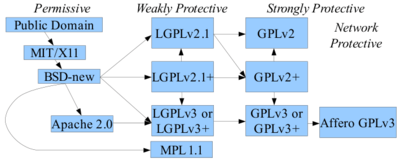Permissive software licence

A Permissive software license, sometimes also called BSD-like or BSD-style license,[2] is a FOSS software licence with minimal requirements about how the software can be redistributed. Examples include the MIT Licence, BSD licences and the Apache licence. As of 2015, the most popular FOSS licence is the permissive MIT licence.[3][4]
Definitions
The Open Source Initiative defines a permissive software license as a "non-copyleft license".[5] GitHub's choosealicense website described the MIT permissive license as, "lets people do anything they want with your code as long as they provide attribution back to you and don’t hold you liable."[6] California Western School of Law's newmediarights.com defined them as follows: "The ‘BSD-like’ licenses such as the BSD, MIT, and Apache licenses are extremely permissive, requiring little more than attributing the original portions of the licensed code to the original developers in your own code and/or documentation.".[2]
Other terms
Copycenter
Copycenter is a term originally used to explain the modified BSD licence, a permissive free software license. The term was presented by Kirk McKusick, a computer scientist famous for his work on BSD, during one of his speeches at BSDCon 1999. It is a word play on copyright, copyleft and copy center.
The way it was characterized politically, you had copyright, which is what the big companies use to lock everything up; you had copyleft, which is free software's way of making sure they can't lock it up; and then Berkeley had what we called ‘copycenter’, which is ‘take it down to the copy center and make as many copies as you want.’
The liberty to 'make as many copies as you want' is in fact also provided by all copyleft licenses. However, unlike both copyleft licenses and copyright law, permissive free software licenses do not control the license terms that a derivative work falls under.
Copyfree


The Copyfree Initiative defines Copyfree as a type of permissive copyright license which falls under their Copyfree Standard Definition.[8]
Copyfree licenses include the Simplified BSD licence, the Open Works license, and others, but not the GNU GPL or other copyleft licenses. The Creative Commons CC0 public domain dedication and the WTFPL license are also considered to be copyfree.[9]
While all copyfree licenses are permissive licenses, not all permissive licenses are copyfree, since they may introduce limitations not allowed under the copyfree definition. Therefore "copyfree" can be seen as subset of "Free and open-source (software)". The Apache Licence 2.0 (as well as previous versions of this license) is an example of a non-copyfree permissive licence.[10] Another notable example is the Creative Commons Attribution 3.0 license, which is also non-compliant with the Copyfree Standard Definition because the license forbids DRM technologies.
Comparison to public domain
Computer Associates Int'l v. Altai used the term "public domain" to refer to works that have become widely shared and distributed under permission, rather than work that was deliberately put into the public domain. However, permissive licenses are not actually equivalent to releasing a work into the public domain.
Permissive licenses often do stipulate some limited requirements, such as that the original authors must be credited (attribution). If a work is truly in the public domain, this is usually not legally required, but a United States copyright registration requires disclosing material that has been previously published,[12] and attribution may still be considered an ethical requirement in academia.
Comparison to copyleft
A major difference between the set of permissive and copyleft free software licenses is that when the software is being redistributed (either modified or unmodified), permissive licenses don't enforce the redistributor to open the modified source code. Copyleft ("sharealike") licenses enforce the publication of the source code under the copyleft license.[13][14] Some people argue that copyleft licenses see the world as "evil" and therefore enforce "freedoms" ("availability of source code") while permissive licenses see the world as "good", therefore just allowing good actions and hoping for giving back in form of source code.[15] Permissive licenses don't try to guarantee that future generations of the software will remain free and publicly available, in contrast to licenses which have reciprocity / share-alike requirements which try to enforce this.
The FreeBSD project argues on the advantages of permissive licenses for companies and commercial use-cases: they place only "minimal restrictions on future behavior" and aren't "legal time-bombs", unlike copyleft licenses.[16]
Also permissive licenses have often an excellent licence compatibility,[17][18] in comparison to copyleft licenses who can't be always freely combined and mixed.[19][20] However, most GPLv2 licensed software allows to upgrade to the terms of later versions of the GPL, achieving by that a somewhat better inter-GPL compatibility. Also, some copyleft licenses have exception clauses that allow combining them with software that is under different licenses or license versions.[21]
License compatibility

In general permissive licenses show a good licence compatibility with most other software licenses in most situations.[17][18]
Due to their non-restrictiveness most permissive software licenses are even compatible with copyleft licenses, which are incompatible with most other licenses. Copyleft licenses don't allow the addition of additional restrictive clauses which would be often required in a combined work made from copyleft code and other licensed code. Only some older permissive licenses have clauses requiring advertising materials to credit the copyright holder which made them incompatible with copyleft licenses, for instance the 4-clause BSD license, the PHP Licence, and the OpenSSL License. Popular modern permissive licenses, as the MIT Licence, the 3-clause BSD licence, and the Zlib Licence, don't include advertising clauses and are compatible with many copyleft licenses.
Some licenses do not allow derived works to add a restriction that says a redistributor cannot add more restrictions. Examples include the CDDL and MsPL. However such restrictions also make the license incompatible with permissive free software licenses.
Some licenses are permissive but do not qualify as free software licenses as defined by the Free Software Foundation.
Reception and adoption
While always an important part of the FOSS license landscape, in the 2010s years several authors noted a raising popularity of the permissive licenses in contrast to the copyleft license.[23][24][25][26]
As of 2015, a permissive license, the MIT licence, became the most popular license in the FOSS domain before a copyleft one, the second placed GPLv2.[3][4]
See also
- License-free software
- Public domain like license
- Free software license
- Comparison of free and open-source software licenses
References
- ↑ Open Source from a Proprietary Perspective at the Wayback Machine (archive index)
- 1 2 New Media Rights (2008-09-12). "Open Source Licensing Guide". California Western School of Law.
- 1 2 "Top 20 licenses". Black Duck Software. 19 November 2015. Retrieved 19 November 2015.
1. MIT license 24%, 2. GNU General Public License (GPL) 2.0 23%, 3. Apache License 16%, 4. GNU General Public License (GPL) 3.0 9%, 5. BSD License 2.0 (3-clause, New or Revised) License 6%, 6. GNU Lesser General Public License (LGPL) 2.1 5%, 7. Artistic License (Perl) 4%, 8. GNU Lesser General Public License (LGPL) 3.0 2%, 9. Microsoft Public License 2%, 10. Eclipse Public License (EPL) 2%
- 1 2 Balter, Ben (2015-03-09). "Open source license usage on GitHub.com". github.com. Retrieved 2015-11-21.
"1 MIT 44.69%, 2 Other 15.68%, 3 GPLv2 12.96%, 4 Apache 11.19%, 5 GPLv3 8.88%, 6 BSD 3-clause 4.53%, 7 Unlicense 1.87%, 8 BSD 2-clause 1.70%, 9 LGPLv3 1.30%, 10 AGPLv3 1.05%
- ↑ permissive on opensource.org "A "permissive" license is simply a non-copyleft open source license — one that guarantees the freedoms to use, modify, and redistribute, but that permits proprietary derivative works."
- ↑ Choosing an open source license doesn’t need to be scary on choosealicense.com "Which of the following best describes your situation? - I want it simple and permissive."
- ↑ The Jargon File contributors (2006). "copycenter". The Jargon File. Eric S. Raymond. Retrieved June 14, 2006.
- ↑ "Copyfree Standard Definition". Copyfree Initiative.
- ↑ Anonymous. Copyfree Licenses. Copyfree. URL:http://copyfree.org/licenses/. Accessed: 2013-04-29. (Archived by WebCite® at http://www.webcitation.org/6GFsj0kGe)
- ↑ "Copyfree: standard > rejected". Copyfree Initiative. Retrieved 2014-10-26.
Section 4, subsections 2 and 4 of the Apache License 2.0 violate point 3. Free Modification and Derivation of the Copyfree Standard Definition by specifying conditions (beyond licensing) that must apply to modifications.
- ↑ "Downloads". Creative Commons. 2015-12-16. Retrieved 2015-12-24.
- ↑ US Copyright Office Form CO; see also Ashton-Tate v. Fox
- ↑ "What is Copyleft". GNU. Retrieved 21 April 2011.
- ↑ "Categories of free and nonfree software". gnu.org.
- ↑ Tavares, Gregg (2005-06-01). "Time for the GPL to die". Retrieved 2015-11-27.
'
- ↑ Montague, Bruce (2013-11-13). "Why you should use a BSD style license for your Open Source Project - GPL Advantages and Disadvantages". FreeBSD. Retrieved 2015-11-28.
In contrast to the GPL, which is designed to prevent the proprietary commercialization of Open Source code, the BSD license places minimal restrictions on future behavior. This allows BSD code to remain Open Source or become integrated into commercial solutions, as a project's or company's needs change. In other words, the BSD license does not become a legal time-bomb at any point in the development process. In addition, since the BSD license does not come with the legal complexity of the GPL or LGPL licenses, it allows developers and companies to spend their time creating and promoting good code rather than worrying if that code violates licensing.
- 1 2 "License Compatibility and Interoperability". Open-Source Software - Develop, share, and reuse open source software for public administrations. joinup.ec.europa.eu. Retrieved 2015-05-30.
The licenses for distributing free or open source software (FOSS) are divided in two families: permissive and copyleft. Permissive licenses (BSD, MIT, X11, Apache, Zope) are generally compatible and interoperable with most other licenses, tolerating to merge, combine or improve the covered code and to re-distribute it under many licenses (including non-free or “proprietary”).
- 1 2 Hanwell, Marcus D. (2014-01-28). "Should I use a permissive license? Copyleft? Or something in the middle?". opensource.com. Retrieved 2015-05-30.
Permissive licensing simplifies things One reason the business world, and more and more developers [...], favor permissive licenses is in the simplicity of reuse. The license usually only pertains to the source code that is licensed and makes no attempt to infer any conditions upon any other component, and because of this there is no need to define what constitutes a derived work. I have also never seen a license compatibility chart for permissive licenses; it seems that they are all compatible.
- ↑ "Frequently Asked Questions about the GNU Licenses – Is GPLv3 compatible with GPLv2?". gnu.org. Retrieved 2014-06-03.
No. Some of the requirements in GPLv3, such as the requirement to provide Installation Information, do not exist in GPLv2. As a result, the licenses are not compatible: if you tried to combine code released under both these licenses, you would violate section 6 of GPLv2. However, if code is released under GPL "version 2 or later," that is compatible with GPLv3 because GPLv3 is one of the options it permits.
- ↑ Landley, Rob. "CELF 2013 Toybox talk". landley.net. Retrieved 2013-08-21.
GPLv3 broke "the" GPL into incompatible forks that can't share code.
- ↑ "GPL-Compatible Free Software Licenses". 2014-11-20. Retrieved 2014-12-29.
- ↑ The Free-Libre / Open Source Software (FLOSS) License Slide by David A. Wheeler on September 27, 2007
- ↑ Vaughan-Nichols, Steven J. "The fall of GPL and the rise of permissive open-source licenses". zdnet.com. Retrieved 2015-11-28.
The GPL is still the world's most popular open-source license but it's declining in use, while permissive licenses are gaining more fans, and some developers are choosing to release code without any license at all.
- ↑ Ronacher, Armin (2013-07-23). "Licensing in a Post Copyright World". lucumr.pocoo.org. Retrieved 2015-11-18.
- ↑ Aslett, Matthew (2011-06-06). "The trend towards permissive licensing". the451group.com. Retrieved 2015-11-28.
- ↑ Does your code need a license? Posted 02 May 2013 by Jason Hibbets "Q: Are there software development companies favoring a certain open source license over another? What is the trend in the community? A: We're definitely seeing some trends away from copyleft licenses—mostly towards permissive licenses"
External links
| Wikibooks has a book on the topic of: FOSS Licensing |
- Critical discussion of the term on copyfree.org
